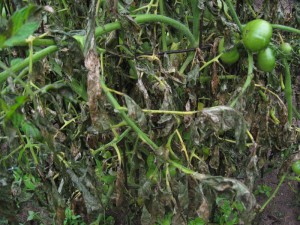
Late blight disease on tomatoes. Photo courtesy Purdue University Plant and Pest Diagnostic Laboratory
West Lafayette, Ind. — The Purdue University Plant and Pest Diagnostic Laboratory has confirmed late blight infecting tomatoes in several Indiana counties, including Tippecanoe, Vermillion and Bartholomew.
“Both home growers and commercial growers of tomatoes should be vigilant ,” said Dan Egel, Purdue Extension plant pathologist. “Indiana is second in the nation in growing processing tomatoes, so there is a lot of potential for economic impact.”
Symptoms are large, olive green to brown spots on leaves with a slightly fuzzy, white fungal growth on the underside when conditions have been humid.
“Sometimes the lesion border is yellow or has a water-soaked appearance,” he said. “Leaf lesions begin as tiny, irregularly shaped brown spots. Also, brown to blackish lesions develop on upper stems, while firm, brown spots develop on the tomato fruit.”
Growers who identify late blight should plow under or pull out and destroy infected plants, Egel said.
“Home growers should discard the infected plants in trash bags and not place them in compost piles,” he said. “It’s important to also remove neighboring plants because they will be infected, too.
“Commercial growers should assume that the disease will infect their plants and apply the appropriate fungicide. Good fungicide coverage is critical. Pathogen spores can be moved on equipment and workers; therefore, growers should spray and work in affected fields last and clean equipment between fields.”
The most recent information will be posted at the Purdue Plant and Pest Diagnostic Laboratory Web site and on the Vegetable Crop Hotline Web site.
Late blight can be slowed, but there are no tools to completely stop its spread. The last time Egel said he saw late blight in Indiana was in 1998 on potatoes in Knox County.
“It is believed that infected tomato plants were shipped to large retail stores throughout the northeast region of the country,” said Gail Ruhl, senior plant disease diagnostician. “The fact that infected plants were introduced early in the season and that we’ve had wet, cool conditions have excelled the spreading of spores.”
Late blight is a fast-moving and highly destructive disease of tomatoes and potatoes if conditions are right.
“I had a report that a lady called and said she checked her tomato plot July 30 and then went back three days later and they were all melted down,” Ruhl said. “They went from looking great to looking bad.”
For questions and more information, contact Egel at (812)886-0198, egel@purdue.edu.
Photos of disease plants also available at Cornell University and Cornell’s Vegetable MD.
